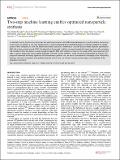Two-step machine learning enables optimized nanoparticle synthesis
Author(s)
Mekki-Berrada, Flore; Ren, Zekun; Huang, Tan; Wong, Wai Kuan; Zheng, Fang; Xie, Jiaxun; Tian, Isaac Parker Siyu; Jayavelu, Senthilnath; Mahfoud, Zackaria; Bash, Daniil; Hippalgaonkar, Kedar; Khan, Saif; Buonassisi, Tonio; Li, Qianxiao; Wang, Xiaonan; ... Show more Show less
DownloadPublished version (1.440Mb)
Publisher with Creative Commons License
Publisher with Creative Commons License
Creative Commons Attribution
Terms of use
Metadata
Show full item recordAbstract
<jats:title>Abstract</jats:title><jats:p>In materials science, the discovery of recipes that yield nanomaterials with defined optical properties is costly and time-consuming. In this study, we present a two-step framework for a machine learning-driven high-throughput microfluidic platform to rapidly produce silver nanoparticles with the desired absorbance spectrum. Combining a Gaussian process-based Bayesian optimization (BO) with a deep neural network (DNN), the algorithmic framework is able to converge towards the target spectrum after sampling 120 conditions. Once the dataset is large enough to train the DNN with sufficient accuracy in the region of the target spectrum, the DNN is used to predict the colour palette accessible with the reaction synthesis. While remaining interpretable by humans, the proposed framework efficiently optimizes the nanomaterial synthesis and can extract fundamental knowledge of the relationship between chemical composition and optical properties, such as the role of each reactant on the shape and amplitude of the absorbance spectrum.</jats:p>
Date issued
2021Department
Singapore-MIT Alliance in Research and Technology (SMART); Massachusetts Institute of Technology. Department of Mechanical EngineeringJournal
npj Computational Materials
Publisher
Springer Science and Business Media LLC
Citation
Mekki-Berrada, Flore, Ren, Zekun, Huang, Tan, Wong, Wai Kuan, Zheng, Fang et al. 2021. "Two-step machine learning enables optimized nanoparticle synthesis." npj Computational Materials, 7 (1).
Version: Final published version